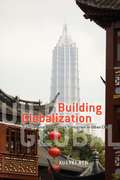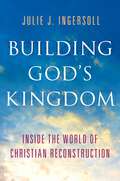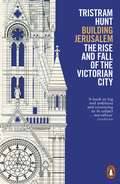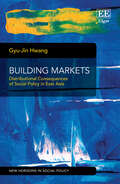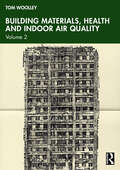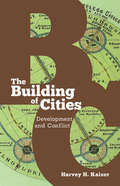- Table View
- List View
Building Globalization: Transnational Architecture Production in Urban China
by Xuefei RenFrom the years 2004 to 2008, Beijing and Shanghai witnessed the construction of an extraordinary number of new buildings, many of which were designed by architectural firms overseas. Combining ethnographic fieldwork, historical research, and network analysis, Building Globalization closely scrutinizes the growing phenomenon of transnational architecture and its profound effect on the development of urban space. Roaming from construction sites in Shanghai to architects’ offices in Paris, Xuefei Ren interviews hundreds of architects, developers, politicians, residents, and activists to explore this issue. She finds that in the rapidly transforming cities of modern China, iconic designs from prestigious international architects help private developers to distinguish their projects, government officials to advance their careers, and the Chinese state to announce the arrival of modern China on the world stage. China leads the way in the globalization of architecture, a process whose ramifications can be felt from Beijing to Dubai to Basel. Connecting the dots between real estate speculation, megaproject construction, residential displacement, historical preservation, housing rights, and urban activism, Building Globalization reveals the contradictions and consequences of this new, global urban frontier.
Building Globalization: Transnational Architecture Production in Urban China
by Xuefei RenFrom the years 2004 to 2008, Beijing and Shanghai witnessed the construction of an extraordinary number of new buildings, many of which were designed by architectural firms overseas. Combining ethnographic fieldwork, historical research, and network analysis, Building Globalization closely scrutinizes the growing phenomenon of transnational architecture and its profound effect on the development of urban space. Roaming from construction sites in Shanghai to architects’ offices in Paris, Xuefei Ren interviews hundreds of architects, developers, politicians, residents, and activists to explore this issue. She finds that in the rapidly transforming cities of modern China, iconic designs from prestigious international architects help private developers to distinguish their projects, government officials to advance their careers, and the Chinese state to announce the arrival of modern China on the world stage. China leads the way in the globalization of architecture, a process whose ramifications can be felt from Beijing to Dubai to Basel. Connecting the dots between real estate speculation, megaproject construction, residential displacement, historical preservation, housing rights, and urban activism, Building Globalization reveals the contradictions and consequences of this new, global urban frontier.
Building God's Kingdom: Inside the World of Christian Reconstruction
by Julie J. IngersollFor the last several decades, at the far fringes of American evangelical Christianity has stood an intellectual movement known as Christian Reconstruction. The proponents of this movement embrace a radical position: that all of life should be brought under the authority of biblical law as it is contained in both the Old and New Testaments. They challenge the legitimacy of democracy, argue that slavery is biblically justifiable, and support the death penalty for all manner of "crimes" described in the Bible including homosexuality, adultery, and Sabbath-breaking. But, as Julie Ingersoll shows in this fascinating new book, this "Biblical Worldview" shapes their views not only on political issues, but on everything from private property and economic policy to history and literature. Holding that the Bible provides a coherent, internally consistent, and all-encompassing worldview, they seek to remake the entirety of society--church, state, family, economy--along biblical lines. Tracing the movement from its mid-twentieth-century origins in the writings of theologian and philosopher R.J. Rushdoony to its present-day sites of influence, including the Christian Home School movement, advocacy for the teaching of creationism, and the development and rise of the Tea Party, Ingersoll illustrates how Reconstructionists have broadly and subtly shaped conservative American Protestantism over the course of the late-twentieth and early-twenty-first centuries. Drawing on interviews with Reconstructionists themselves as well as extensive research in Reconstructionist publications, Building God's Kingdom offers the most complete and balanced portrait to date of this enigmatic segment of the Christian Right.
Building God's Kingdom: Inside the World of Christian Reconstruction
by Julie J. IngersollFor the last several decades, at the far fringes of American evangelical Christianity has stood an intellectual movement known as Christian Reconstruction. The proponents of this movement embrace a radical position: that all of life should be brought under the authority of biblical law as it is contained in both the Old and New Testaments. They challenge the legitimacy of democracy, argue that slavery is biblically justifiable, and support the death penalty for all manner of "crimes" described in the Bible including homosexuality, adultery, and Sabbath-breaking. But, as Julie Ingersoll shows in this fascinating new book, this "Biblical Worldview" shapes their views not only on political issues, but on everything from private property and economic policy to history and literature. Holding that the Bible provides a coherent, internally consistent, and all-encompassing worldview, they seek to remake the entirety of society--church, state, family, economy--along biblical lines. Tracing the movement from its mid-twentieth-century origins in the writings of theologian and philosopher R.J. Rushdoony to its present-day sites of influence, including the Christian Home School movement, advocacy for the teaching of creationism, and the development and rise of the Tea Party, Ingersoll illustrates how Reconstructionists have broadly and subtly shaped conservative American Protestantism over the course of the late-twentieth and early-twenty-first centuries. Drawing on interviews with Reconstructionists themselves as well as extensive research in Reconstructionist publications, Building God's Kingdom offers the most complete and balanced portrait to date of this enigmatic segment of the Christian Right.
Building Inclusive Cities: Women’s Safety and the Right to the City
by Carolyn Whitzman Crystal Legacy Caroline Andrew Fran Klodawsky Margaret Shaw Kalpana ViswanathBuilding on a growing movement within developing countries in Latin America, Africa, and Asia-Pacific, as well as Europe and North America, this book documents cutting edge practice and builds theory around a rights based approach to women’s safety in the context of poverty reduction and social inclusion. Drawing upon two decades of research and grassroots action on safer cities for women and everyone, this book is about the right to an inclusive city. The first part of the book describes the challenges that women face regarding access to essential services, housing security, liveability and mobility. The second part of the book critically examines programs, projects and ideas that are working to make cities safer. Building Inclusive Cities takes a cross-cultural learning perspective from action research occurring throughout the world and translates this research into theoretical conceptualizations to inform the literature on planning and urban management in both developing and developed countries. This book is intended to inspire both thought and action.
Building Inclusive Cities: Women’s Safety and the Right to the City
by Carolyn Whitzman Crystal Legacy Caroline Andrew Fran Klodawsky Margaret Shaw Kalpana ViswanathBuilding on a growing movement within developing countries in Latin America, Africa, and Asia-Pacific, as well as Europe and North America, this book documents cutting edge practice and builds theory around a rights based approach to women’s safety in the context of poverty reduction and social inclusion. Drawing upon two decades of research and grassroots action on safer cities for women and everyone, this book is about the right to an inclusive city. The first part of the book describes the challenges that women face regarding access to essential services, housing security, liveability and mobility. The second part of the book critically examines programs, projects and ideas that are working to make cities safer. Building Inclusive Cities takes a cross-cultural learning perspective from action research occurring throughout the world and translates this research into theoretical conceptualizations to inform the literature on planning and urban management in both developing and developed countries. This book is intended to inspire both thought and action.
Building Information Modeling for a Smart and Sustainable Urban Space
by Rafika Hajji Hassane Jarar OulidiBuilding Information Modeling for a Smart and Sustainable Urban Space
by Hassane Jarar Oulidi Rafika HajjiSynopsis not available.
Building Institution: The Institute for Architecture and Urban Studies, New York 1967-1985 (Architekturen #84)
by Kim Förster»Building Institution« chronicles the expansion of architecture as a profession and discipline in the postmodern era. Kim Förster traces the compelling history of the Institute for Architecture and Urban Studies, which was active in New York from 1967 to 1985. Drawing on extensive archival research and oral histories, he constructs a collective biography that details the Institute's diverse roles and the dynamic interplay between research and design, education, culture, and publishing. By exploring the transformation of cultural production into a practice as well as the culturalization and global postmodernization of architecture, the volume contributes significantly to the institutional history of architecture.
Building Institutions for Resilience: Combatting Climate Change (Sustainable Development Goals Series)
by Andrew Simmons Andree-Ann SimmonsThis volume uses a case study approach to present data on the relevance and effectiveness of the strategic actions implemented by NGOs, IGOs and governments at national, regional, and international scales, drawing lessons and recommendations to enhance the capacity of governments and institutions to deliver on climate change adaptation and sustainable development initiatives. The authors provide insights to policymakers, community leaders, students and researchers working on climate change adaptation and resilience-building practices and strategies in vulnerable communities, including small island developing states and post-conflict states, focusing on innovative management practices and institutional capacity building. The cases presented here provide insights into how institutions can strengthen local, national, and regional capacities to adapt to climate change and other calamities.
Building Jerusalem: The Rise and Fall of the Victorian City
by Tristram Hunt'History writing at its compulsive best' A. N. WilsonThis is a history of the ideas that shaped not only London, but Manchester, Glasgow, Liverpool, Leeds, Birmingham, Sheffield and other power-houses of 19th-century Britain. It charts the controversies and visions that fostered Britain's greatest civic renaissance.Tristram Hunt explores the horrors of the Victorian city, as seen by Dickens, Engels and Carlyle; the influence of the medieval Gothic ideal of faith, community and order espoused by Pugin and Ruskin; the pride in self-government, identified with the Saxons as opposed to the Normans; the identification with the city republics of the Italian renaissance - commerce, trade and patronage; the change from the civic to the municipal, and greater powers over health, education and housing; and finally at the end of the century, the retreat from the urban to the rural ideal, led by William Morris and the garden-city movement of Ebenezer Howard.
Building Legitimacy: Exploring State–Society Relations in Northeast India
by M. Sajjad HassanThis book compares two states in the Northeast with different socio-political trajectories—a relatively orderly Mizoram and a troubled Manipur—in order to understand the sources of political turmoil in the region. Taking the region as a case study, it examines the larger debates on success and failure in state-making. In discussing the divergent success of the two states in mitigating conflicts, Hassan demonstrates how in Mizoram the process of state-making helped consolidate public legitimacy and the authority of state leaders. He also shows how it strengthened the institutional capability of government agencies to provide services, manage group contestations, and avoid breakdown. At the same time, he illustrates how in Manipur, traditional centres of power—tribal and ethnic associations—gained in authority, compromising the legitimacy of the government and institutional capability of its agencies. The study highlights the important role, in the context of state breakdown, of the absence of an effective medium to regulate inter-group relationships and manage contestations over power, resources, opportunities, and identity. Rigorously comparative, it explains the sources of disorder in Northeast India by focusing on the nature of state–society relations in the region. While acknowledging the important role of history in structuring this failure of the state system in the region, it suggests ways in which the path dependence can be overcome.
Building Markets: Distributional Consequences of Social Policy in East Asia (New Horizons in Social Policy series)
by Gyu-Jin HwangNowhere in the world presents a more dramatic case of wealth creation than East Asia. Contrary to the common belief that social policy in the economic powerhouses of the region is secondary to their pursuit of economic growth, Gyu-Jin Hwang argues that it has in fact played an integral part in building strong states and competitive market economies. Building Markets examines the original four Newly Industrialised Economies (NIEs) of East Asia: Hong Kong, Korea, Singapore, and Taiwan, as well as Japan, the regional forerunner in both economic and social terms. Chapters undertake a comparative analysis of the various social policy measures and redistributive efforts taken across a diverse range of social policy sectors in the region, covering cash transfers, healthcare, education, housing, and family policy. Addressing the mounting pressure on East Asian economies to rethink their growth strategies, Hwang concludes with a call for social means to be diverted, adapted, and converted to serve new social ends. Integrating cutting-edge theoretical insights with detailed policy analysis, Building Markets will be an invaluable tool for academics and postgraduate students interested in social policy, economics, and development in East Asia.
Building Materials, Health and Indoor Air Quality: Volume 2
by Tom WoolleyIn Building Materials, Health and Indoor Air Quality: Volume 2 Tom Woolley uses new research to continue to advocate for limiting the use of hazardous materials in construction and raise awareness of the links between pollutants found in building materials, poor indoor air quality and health problems. Chapters in this volume reinforce previous arguments and present new ones covering: Further evidence of the health impacts of hazardous emissions from materials Hazardous materials to be avoided and why Fire and smoke toxicity – the Lakanal House and Grenfell Tower legacy Sub-standard retrofits leading to damp and mould in previously sound houses A critical review of recent reports from UK Government and others on air quality and health problems including policy changes on flame retardants Growing evidence of cancer risks and the failure of cancer research organisations to address these issues A critical review of recent climate change and zero carbon policies and a discussion on whether extreme energy efficiency is a good thing This book asks some important and, for some, uncomfortable questions, but in doing so it brings to light important areas for research and provides much needed guidance for architects, engineers, construction professionals, students and researchers on hazardous materials and how to reduce their use and design and build healthier buildings for all occupants.
Building Materials, Health and Indoor Air Quality: Volume 2
by Tom WoolleyIn Building Materials, Health and Indoor Air Quality: Volume 2 Tom Woolley uses new research to continue to advocate for limiting the use of hazardous materials in construction and raise awareness of the links between pollutants found in building materials, poor indoor air quality and health problems. Chapters in this volume reinforce previous arguments and present new ones covering: Further evidence of the health impacts of hazardous emissions from materials Hazardous materials to be avoided and why Fire and smoke toxicity – the Lakanal House and Grenfell Tower legacy Sub-standard retrofits leading to damp and mould in previously sound houses A critical review of recent reports from UK Government and others on air quality and health problems including policy changes on flame retardants Growing evidence of cancer risks and the failure of cancer research organisations to address these issues A critical review of recent climate change and zero carbon policies and a discussion on whether extreme energy efficiency is a good thing This book asks some important and, for some, uncomfortable questions, but in doing so it brings to light important areas for research and provides much needed guidance for architects, engineers, construction professionals, students and researchers on hazardous materials and how to reduce their use and design and build healthier buildings for all occupants.
Building Materials, Health and Indoor Air Quality: Volume 2
by Tom WoolleyIn Building Materials, Health and Indoor Air Quality: Volume 2 Tom Woolley uses new research to continue to advocate for limiting the use of hazardous materials in construction and raise awareness of the links between pollutants found in building materials, poor indoor air quality and health problems. Chapters in this volume reinforce previous arguments and present new ones covering: Further evidence of the health impacts of hazardous emissions from materials Hazardous materials to be avoided and why Fire and smoke toxicity – the Lakanal House and Grenfell Tower legacy Sub-standard retrofits leading to damp and mould in previously sound houses A critical review of recent reports from UK Government and others on air quality and health problems including policy changes on flame retardants Growing evidence of cancer risks and the failure of cancer research organisations to address these issues A critical review of recent climate change and zero carbon policies and a discussion on whether extreme energy efficiency is a good thing This book asks some important and, for some, uncomfortable questions, but in doing so it brings to light important areas for research and provides much needed guidance for architects, engineers, construction professionals, students and researchers on hazardous materials and how to reduce their use and design and build healthier buildings for all occupants.
Building Materials, Health and Indoor Air Quality: Volume 2
by Tom WoolleyIn Building Materials, Health and Indoor Air Quality: Volume 2 Tom Woolley uses new research to continue to advocate for limiting the use of hazardous materials in construction and raise awareness of the links between pollutants found in building materials, poor indoor air quality and health problems. Chapters in this volume reinforce previous arguments and present new ones covering: Further evidence of the health impacts of hazardous emissions from materials Hazardous materials to be avoided and why Fire and smoke toxicity – the Lakanal House and Grenfell Tower legacy Sub-standard retrofits leading to damp and mould in previously sound houses A critical review of recent reports from UK Government and others on air quality and health problems including policy changes on flame retardants Growing evidence of cancer risks and the failure of cancer research organisations to address these issues A critical review of recent climate change and zero carbon policies and a discussion on whether extreme energy efficiency is a good thing This book asks some important and, for some, uncomfortable questions, but in doing so it brings to light important areas for research and provides much needed guidance for architects, engineers, construction professionals, students and researchers on hazardous materials and how to reduce their use and design and build healthier buildings for all occupants.
Building More Effective Unions
by Paul F. ClarkEmployers have long turned to behavioral science for guidance on making their organizations more effective. Labor scholar Paul F. Clark believes union leaders should also take advantage of the valuable discoveries made in this field, and he offers a straightforward account of how they can do so.Much of the behavioral science research relevant to unions relies on complex statistical analyses and is disseminated through scholarly journals. This clearly written book makes the findings of behavioral science accessible to those committed to building a stronger labor movement. It describes behavioral science's understanding of such topics as organizational commitment and member participation and suggests how this knowledge can best be applied to unions.Building More Effective Unions offers practical strategies unions can use to their advantage in a number of areas, including:-Union participation-Organization and retention -Union orientation and socialization-Political action-Grievance procedures-Information and communications -Union image-building-Union culture-Union leadershipThe book features examples of how unions and their leaders have benefited from putting the principles of behavioral science into practice.
Building New Labour: The Politics of Party Organisation
by M. Russell'New' Labour was defined in part by wide-ranging reforms to the party's internal democracy. These included changes to how candidates and leaders are selected, changes to policy making processes, and a programme of 'quotas' that transformed women's representation in the party. In the first book to analyse all these reforms in depth Meg Russell asks what motivated them, to what extent they were driven by leaders or members, and what they can teach us both about party organisational change and the nature of power relations in the Labour Party today.
The Building of Cities: Development and Conflict
by Harvey H. KaiserIn this classic book that records a moment in the history of urban planning, the architect and city planner Harvey H. Kaiser examines the city-building process from the time when a proposal for urban development is first conceived to the early stages of construction. Lysander (near Syracuse) and Gananda and Riverton (both near Rochester). These were brand-new developments and municipalities, and thus quite different from other trends of suburbanization that attached development onto existing municipalities. Step by step, he describes what happened in each of these communities during the presentation of the initial proposal, how parties interacted with each other, and how the climate of the community influenced the actions of the parties. Basing his work on hundreds of interviews, attendance at public meetings, and a review of many articles and documents, Kaiser shows that in each case the emergence of controversy and degree of acceptance was influenced by the developer's leadership, the characteristics of the developer's organization, and the method of presenting the proposal to the public. Kaiser brings to his comparative approach a background in the rough and tumble of day-to-day project management and the development of plans as well as their administration. The Building of Cities is an invaluable resource for developers, architects, public officials, and citizens involved in local government.
The Building of Civil Europe 1951–1972
by Stefanie PukallusThis book argues that early European Commission officials envisaged an integrated civil Europe from the outset. Largely overlooked is the fact that between 1951 and 1972 there was a group of European Commission (and before that the High Authority) officials who wished to build a Civil Europe to sit alongside an economic and political Europe. This Civil Europe was, it was hoped, to become home to a European citizenry equipped with a European civil consciousness that complemented their national and local loyalties. To this end these officials pioneered a series of civil initiatives designed to begin the process of building Civil Europe. This book analyses three such civil initiatives: the building of the first European School, the European Community’s participation in Expo 58 and the production of the European Community’s own documentaries. From the start Europe was designed and conceived of in terms of a European general civil public and not solely in terms dictated by economic and political interests.
Building on the past: Visions of housing futures
by Peter Malpass Liz CairncrossDespite the improved supply and quality of housing in the UK and Europe over the last 60 years, the future of housing remains uncertain. Will the supply of new housing meet demand? Is decent, affordable housing an achievable goal? How far will governments seek to shape the market? How will they respond to demographic pressures in different parts of the country? Will housing wealth become a central issue in wider debates about the future of public services? This book looks at the big questions affecting the future of housing as a key indicator of social and economic well-being in the 21st century. It brings together specially commissioned contributions by leading housing experts who explore a wide range of themes and issues affecting the prospects for the coming 20 years or more. Drawing on the evidence of the past and present they analyse the implications of current trends to consider how markets and governments might respond to the challenges ahead. The book is not a work of prophecy or a manifesto for action. It is designed to stimulate and contribute to informed debate about possible futures and what can be done to influence what happens. Building on the past will be of interest to all those concerned about the future of housing, neighbourhoods and communities over the next 20 years.
Building on the Past: A Guide to the Archaeology and Development Process
by G. McGillThis comprehensive guide provides planners, developers, architects and archaeologists with an analysis of the conflicts between the archaeological development and planning processes. It takes a pragmatic approach to the effects of archaeology on development, enabling practitioners to reach practical solutions where archaeological considerations are taken into account in the development process.
Building on the Past: A Guide to the Archaeology and Development Process
by G. McGillThis comprehensive guide provides planners, developers, architects and archaeologists with an analysis of the conflicts between the archaeological development and planning processes. It takes a pragmatic approach to the effects of archaeology on development, enabling practitioners to reach practical solutions where archaeological considerations are taken into account in the development process.
Building Peace: Feminist Perspectives
by Laura J. ShepherdMoving seamlessly from the global to the local, from the politics of institutions to the theoretical apparatus through which we analyse peace and security governance, the contributions to this volume draw attention to the operations of gendered power in peacebuilding across diverse contexts and explore the possibilities of gender-sensitive, sustainable peace. The authors have wide-ranging expertise in gendered analysis of the peacebuilding practices of international and national organisation, detailed and complex qualitative analysis of the gendered politics of peacebuilding in specific country contexts, and feminist analysis of the tools we use to think with when approaching contemporary debates about peacebuilding. The volume thus serves not only as a useful marker of the development of feminist encounters with peacebuilding but also as a foundation for future scholarship in this area. This book was originally published as a special issue of the journal Peacebuilding.
